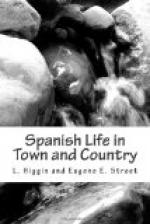The road which runs along the bank of the Manzanares, at the farther side from Madrid, is a revelation to those who only know the plains through which the railway from the north passes, and which for the greater part of the year, except when the crops are growing, are quite as arid as we are accustomed to suppose. On the left lies the Casa de Campo, an immense extent of park, containing, on the high ground, some splendid specimens of the Scotch fir, and, in more sheltered spots, groves of beech, avenues of plane, and masses of the dark-leaved ilex, which grows to great perfection in this climate. The “Florida,” another of the royal properties, lies to the right, and a splendid road shaded by majestic trees, and with wide, grassy margins, stretches away to the village of El Pardillo, where Longfellow established his quarters, and which he describes in his Outre Mer, and from that on to the forest, or whatever you may call it, of El Pardo, where there is a royal residence now but seldom used, you may ride for many hours and still find yourself in this wild park, which many of the inhabitants of Madrid have never seen. Here one can realise a little how the city may have once been a hunting lodge of the Kings, as we are told. The Pardo may be reached through the Casa de Campo, a gate at the extreme end of the principal drive leading into the forest.
Up on the high ground of the Casa de Campo there is a splendid view of Madrid, with the Palace crowning the steep bluff overhanging the Manzanares. It was in the “country house” itself, near the gate, that our “Baby Charles” is said to have climbed the high wall of the courtyard to get a glimpse of the Infanta whom he hoped to make his wife. When I knew the place intimately, on the very highest part of the Park was a large enclosure of the wild forest, railed in with high wooden palisading. Within this lived a flock of ostriches, belonging to the Crown. No one seemed to know anything about them, nor how long they had been there. What puzzled us much was how they were fed, or if they were left to cater for themselves. One thing I can answer for: they were very wild, and very ferocious; the moment they saw our horses coming up the hill they would run from all parts of the enclosure trying their best to get at us, striking with their




